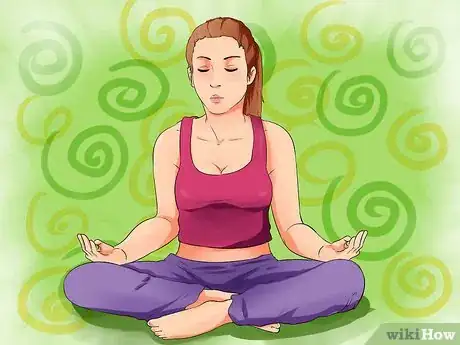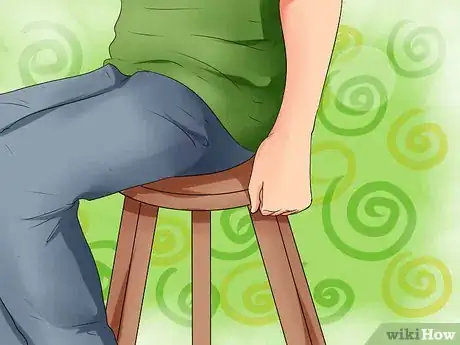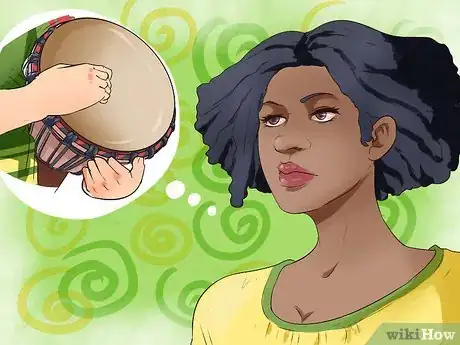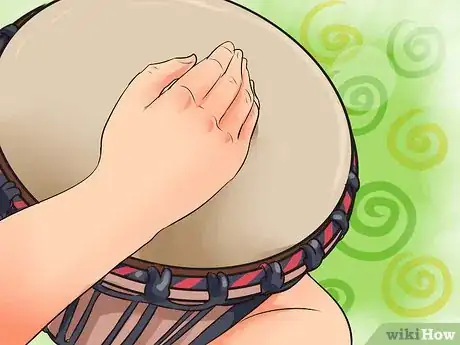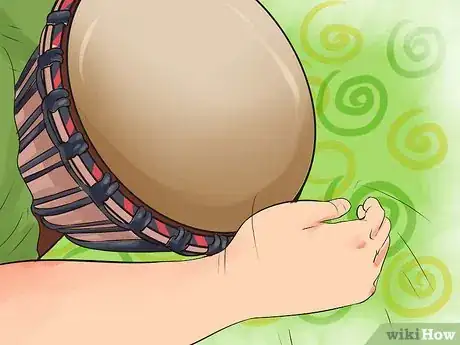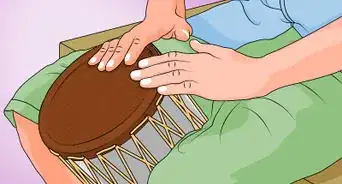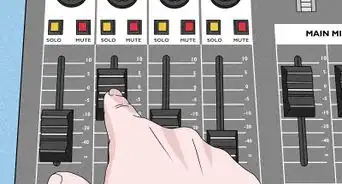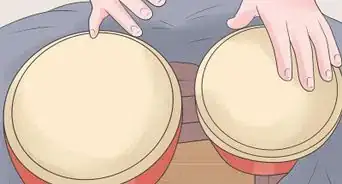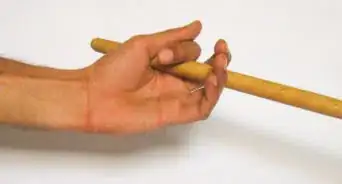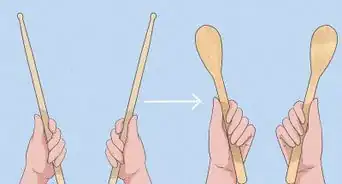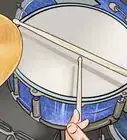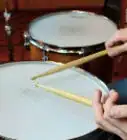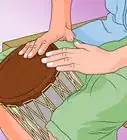wikiHow is a “wiki,” similar to Wikipedia, which means that many of our articles are co-written by multiple authors. To create this article, 20 people, some anonymous, worked to edit and improve it over time.
This article has been viewed 41,707 times.
Learn more...
A djembe is a type of West African drum that is goblet shaped. It is traditionally carved from a single piece of wood with a skin stretched over the top. A djembe is normally 23-25 tall, but can be smaller. Child sized drums are often made so even the young can learn to play.[1] This article addresses the basics of playing this type of drum.
Steps
Warming Up
-
1Warm up your body and get grounded. You should do this before even touching your drum.[2]
- Go for a short walk or run in place.
- Do yoga or tai chi to get grounded into your body before you play.
- Drumming is both a physical and mental exercise, so its important to be prepared.
-
2Make sure your djembe is clean and the skin is tightened correctly.
- If the skin is too loose or too tight, the drum won't produce the right sound.
- You can tune the drum by tightening or loosening the tuning ropes on the side of the drum.
- It is a good idea to use gloves and a rope puller to help you do this.
- Have a friend help you tune the drum.
Advertisement -
3Get in the proper position. You can play the drum standing up, with it placed under your arm. [3]
-
4Place your drum under your arm, keeping it in place with your inner elbow.
- Some djembe players use a strap that goes over the shoulders, keeping the drum in place between their knees.
- Adjust the strap so the drum is sitting at a 90 degree angle with your arms for proper playing. The forearms should form a straight line from fingertips to elbow.
- Keep a good posture, and keep the drum as steady as possible while playing.
-
5Sit on a stool or chair. You can also play the djembe sitting down. [4]
- Tilt your drum slightly away from you and place your arms laterally away from your torso, about 6-8 inches.
- Your hands should rest comfortably on the head of the drum at a 90 degree angle. Your forearms should form a straight line from fingertip to elbow.
- You may need to experiment with different chairs or stools to get one at the proper height for your drum. You can also purchase an adjustable stool.
-
6Get a friend to keep a beat. They can do this either on a conga, or simply on a table or hard surface.
- Keep the beat slow to start with until you get used to how to play the djembe.
- Cup one or both hands, depending on the position of your drum.
- Play a rhythm keeping in time with the beat. Repeat this rhythm over and over again until you are familiar with the rhythm.
- Change rhythm and keep same beat.
Mastering Djembe Technique
-
1Learn how to play out on a roll. Most djembe patterns will be played like this. [5]
- This means that if you fill every note in measure, your hands would alternate left and right.
- In 4/4 time (4 beats per measure), this means that the downbeat and the "+" beat are played with the right hand. The offbeats are played with the left hand.
-
2Make the drum resonate. The type of stroke you use can affect how the drum resonates.
- Each stroke can either be open (let your hand bounce freely off the drum) or closed (press your hand down so that it doesn't bounce of the drum).
- Open strokes are made when you let your hand bounce freely off the drum.
- Closed strokes are made when you press your hand down so that it doesn't bounce off of the drum.
- Open strokes will make the drum resonate more and closed strokes will make it resonate less.
-
3Learn how to produce different tones.There are three basic tones you can produce on the djembe: the bass tone, the open tone, and the slap.[6]
- The bass tone can be produced by hitting near the center with your palm. As soon as your palm hits the drum, let it bounce off like you are bouncing on a trampoline.
- The open tone is made by striking with your knuckles approximately over the rim.
- The slap is done with the heel of your palm in the center of the drum head and your fingers slapping near the far rim. As soon as your fingertips hit the drum head they should rebound like the tip of a bullwhip.
- The slapping stroke is the hardest to get---- practice making the slap as high-pitched as possible.
-
4Strike the drum with different intensities. This will vary the volume.
- Accent some beats and de-emphasize others.
- This will add variety to your sound.
- Experiment with different intensities and different tones at different rhythms.
Community Q&A
-
QuestionHow do I tune a djembe?
 AnonymousSuperWriterCommunity AnswerI highly recommend you to take it to a professional to tune it so it is 100% tuned. Although it will cost a little, it is worth it rather than accidentally breaking it.
AnonymousSuperWriterCommunity AnswerI highly recommend you to take it to a professional to tune it so it is 100% tuned. Although it will cost a little, it is worth it rather than accidentally breaking it.
Warnings
- If you squeeze the drum too tightly it might crack.⧼thumbs_response⧽
Things You'll Need
- Conga/Hard Surface
- Quiet Room
- Djembe
- Friend
References
- ↑ http://www.drumconnection.com/africa-connections/history-of-the-djembe/
- ↑ http://www.larryswanson.com/personal/world-music-dance/djembe-technique/
- ↑ http://www.larryswanson.com/personal/world-music-dance/djembe-technique/
- ↑ http://www.larryswanson.com/personal/world-music-dance/djembe-technique/
- ↑ http://www.larryswanson.com/personal/world-music-dance/djembe-technique/
- ↑ http://www.larryswanson.com/personal/world-music-dance/djembe-technique/
About This Article
If you want to play the djembe, sit or stand with the drum under your arm, tucked into your inner elbow. Experiment with different sounds by using different strokes. For instance, if you let your hand bounce freely off the drum, you’ll get an open sound, and you’ll get a closed sound if you press down and don’t let your hand bounce. To produce a bass sound, hit the drum near the center with your palm. To get a higher-pitched sound, hit closer to the outside edge. For more techniques, like how to produce a slapping sound with the djembe, keep reading!
